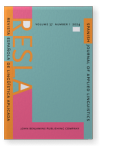Vol. 37:1 (2024) ► pp.233–263
Vol. 37:1 (2024) ► pp.233–263
¿Acercamiento solidario vs. distanciamiento respetuoso?
La percepción del acto de habla de invitación por hablantes españoles e ingleses
A partir de un análisis inicial sobre la naturaleza del acto de habla de invitación y sus relaciones con la (des)cortesía, el presente trabajo contrasta la percepción que hablantes españoles e ingleses tienen sobre dicho acto de habla, con el objetivo de determinar si existen patrones de variación cultural y, en su caso, también de variación social, en este sentido. El análisis, que combina metodología cuantitativa y cualitativa, parte de las respuestas a un cuestionario por 240 informantes (cuidadosamente seleccionados conforme a su procedencia geográfica, edad, sexo y formación académica), a quienes se les muestran dos variantes de un diálogo con una secuencia invitación–rechazo justificado–insistencia en la invitación. Los resultados obtenidos confirman la esperable existencia de diferencias culturales, si bien solo parcialmente coincidentes con los perfiles tradicionalmente descritos por la bibliografía especializada, además de la presencia de parámetros bastante definidos de variación social, tanto transculturales como específicos de una u otra cultura.
Article outline
- 1.Introducción y objetivos
- 2.Marco teórico
- 2.1La invitación y la (des)cortesía
- 2.2Variación cultural y variación social
- 2.3La invitación en hablantes españoles e ingleses
- 2.4La teoría de la gestión interrelacional
- 3.Metodología
- 4.Presentación de los resultados
- 5.Análisis de los resultados
- 6.Discusión
- 7.Conclusiones
- Notas
-
Referencias bibliográficas
Article language: Spanish
